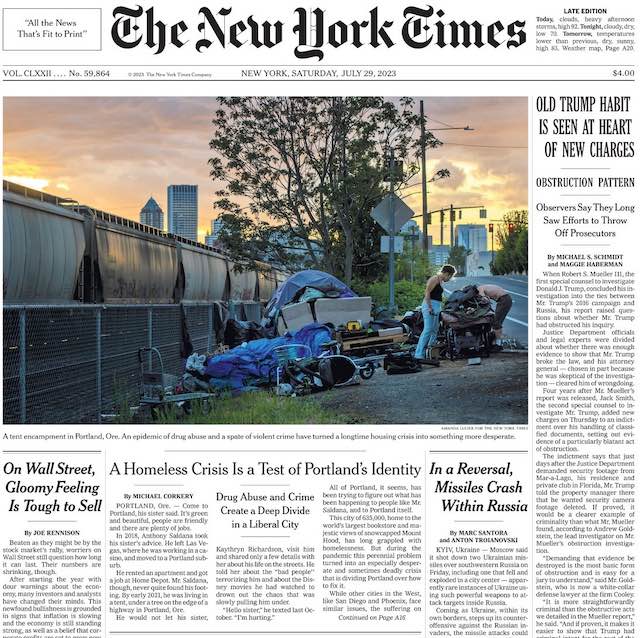A few years ago the New York Times was praising Portland as the “city that loves mass transit” (meaning it loved to spend money on mass transit, not actually ride it) and the city where people were willing to live lightly in 400-square-foot apartments. How the mighty have fallen: Last Saturday, Portland rated most of the top half of the Times front page with an article about homelessness, drug addiction, and death.
Click image for a larger view.
The article and accompanying photos jump to fill two entire interior pages of the newspaper. At around 3,500 words, the article qualifies as a long read, especially for a newspaper. But for many people, including Jack Bogdanski, the article was more notable for what it didn’t say than what it did.
The article didn’t say anything about why housing has become so expensive that it is difficult for newcomers to find a home and they end up being homeless. A recent article from Oregon Public Broadcasting admits that high housing prices could be due to Oregon’s stringent land-use laws, but adds that they could also be due to greedy developers and greedy landowners. Yet greedy developers and landowners are everywhere; only places with stringent controls on rural development have gotten expensive.
The New York Times article claims that the problem is that Portland isn’t doing enough to provide housing for homeless and other low-income people. This is absurd considering that Portland and Oregon are spending billions on so-called affordable housing. But (the Times failed to note) much of this money is being squandered on four- and five-story apartment buildings with inadequate parking that cost two to four times as much per square foot to build as single-family homes, all because the powers that be have decided that low-income people should be transit dependent even though the typical Portland resident can reach 25 times as many jobs in a 30-minute auto drive as a 30-minute transit ride.
The New York Times hints that Portland has been lax about cleaning up homeless camps. But it doesn’t say that Portland police will do nothing if homeless people squat on someones private property, but it will fine the property owners if the junk left behind by the homeless people creates a “nuisance.”
The bottom line is that the New York Times is an advocate for the progressive policies that have laid Portland low and is now scratching its collective head wondering what went wrong. Its conclusion seems to be that it is all due to fentanyl, and if this drug hadn’t shown up, Portland would still be thriving today.
That’s ridiculous; if it wasn’t fentanyl, it would be something else. It is thanks to the progressive policies advocated in the article that Portland has gone from being the place where young people go to retire to a place where (as Bogdanski says) young people go to die.









New York City is compensating 25 million to repairs for hotels damaged by homeless, addicts and migrants.
San Francisco is paying millions to hotels.
Maybe, it’s not a housing crisis.
Thus has more to do with culture and depravity crisis.
DRUGS, fuk you up.
Were not seeing rise bad drugs, were seeing rise Good drugs. Victims of modern chemistry from drugs so potent.
And we honestly cant address how they mess with the brain. But were now dealing with the Libertarian fantasy of “Legalized Narcotics”
As I said, You could solve the Drug War and the drug problem in America in a DAY! With simple Body Autonomy laws. Per your decision as a consenting and able minded adult you are granted a card ID like a drivers license surrendering all responsibility for your body to YOU. The govt cant arrest you for consuming narcotics as long as you don’t sell or distribute to any underage individuals or those without the ID themselves. In exchange for full autonomy to consume any drug you want without legal prosecution, you surrender any taxpayer funded obligation or entitlements to treat or care for you until you give it up ( and proven clean up to one year). No food stamps, no unemployment, no HUD assistance, no welfare. Once you’ve severed the real addiction; The Nanny State. This has two advantages; One without government safety net people will most likely think twice before starting to do drugs and contemplate what they’d rather have…..the right to shoot up or welfare. And two It detaches the burdened taxpayer from the consequences of junkie self destruction. Will there be casualties, Sure but the real tragedy is what the government and self professed experts have done is turn society into addicts of entitlement; the revolving door of perpetual self destruction.
Once we stop attempting to subsidize a lifestyle…. People will wise up
”
that Portland has gone from being the place where young people go to retire to a place where (as Bogdanski says) young people go to die.
“
The point about how people “can reach 25 times as many jobs in a 30-minute auto drive as a 30-minute transit ride” is a powerful one. Of course it also applies to shopping, recreation, friends, family, etc. too.